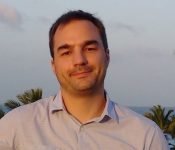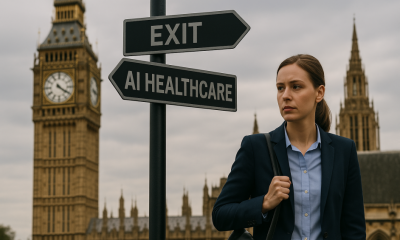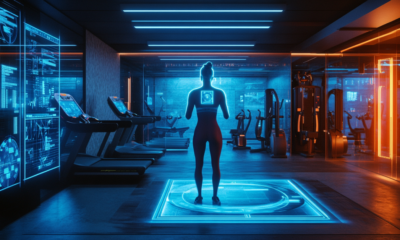Interviews
Allan Hanbury, Co-Founder of contextflow – Interview Series

Allan Hanbury is Professor for Data Intelligence at the TU Wien, Austria, and Faculty Member of the Complexity Science Hub, where he leads research and innovation to make sense of unstructured data. He is initiator of the Austrian ICT Lighthouse Project, Data Market Austria, which is creating a Data-Services Ecosystem in Austria. He was scientific coordinator of the EU-funded Khresmoi Integrated Project on medical and health information search and analysis, and is co-founder of contextflow, the spin-off company commercialising the radiology image search technology developed in the Khresmoi project. He also coordinated the EU-funded VISCERAL project on evaluation of algorithms on big data, and the EU-funded KConnect project on technology for analysing medical text.
contextflow is a spin-off from the Medical University of Vienna and European research project KHRESMOI. Could you tell us about the KHRESMOI project?
Sure! The goal of Khresmoi was to develop a multilingual, multimodal search and access system for biomedical information and documents, which required us to effectively automate the information extraction process, develop adaptive user interfaces and link both unstructured and semi-structured text information to images. Essentially, we wanted to make the information retrieval process for medical professionals reliable, fast, accurate and understandable.
What’s the current dataset which is powering the contextflow deep learning algorithm?
Our dataset contains approximately 8000 lung CTs. As our AI is rather flexible, we’re moving towards brain MRIs next.
Have you seen improvements with how the AI performs as the dataset has become larger?
We're frequently asked this question, and the answer is likely not satisfying to most readers. To a certain extent, yes, the quality improves with more scans, but after a particular threshold, you don't gain much more simply from having more. How much is enough really depends on various factors (organ, modality, disease pattern, etc), and it’s impossible to give an exact number. What's most important is the quality of the data.
Is contextflow designed for all cases, or to simply be used for determining differential diagnosis for difficult cases?
Radiologists are really good at what they do. For the majority of cases, the findings are obvious, and external tools are unnecessary. contextflow has differentiated itself in the market by focusing on general search rather than automated diagnosis. There are a few use cases for our tools, but the main one is for helping with difficult cases where the findings aren’t immediately apparent. Here radiologists must consult various resources, and that process takes time. contextflow SEARCH, our 3D image-based search engine) aims to reduce the time it takes for radiologists to search for information during image interpretation by allowing them to search via the image itself. Because we also provide reference information helpful for differential diagnosis, training new radiologists is another promising use case.
Can you walk us through the process of how a radiologist would use the contextflow platform?
contextflow SEARCH Lung CT is completely integrated into the radiologist's workflow (or else they would not use it). The radiologist performs their work as usual, and when they require additional information for a particular patient, they simply select a region of interest in that scan and click the contextflow icon in their workstation to open up our system in a new browser window. From there, they will receive reference cases from our database of patients with similar disease patterns present as the patient they are currently evaluating plus statistics and medical literature (e.g. radiopedia). They can scroll through their patient in our system normally, selecting additional regions to search for additional information and compare side-by-side with the reference cases. There are also heatmaps providing a visualization of the overall distribution of disease patterns, which helps with reporting findings as well. We really tried to put everything a radiologist needs to write a report in one place and available within seconds.

This was designed initially for lung CT scans, will contextflow be expanding to other types of scans?
Yes! We have a list of organs and modalities requested by radiologists that we are eager to add. The ultimate goal is to provide a system that covers the entire human body, regardless of organ or type of scan.
contextflow has received the support of two amazing incubator programs INiTS and i2c TU Wien. How beneficial have these programs been and what have you learned from the process?
We owe a lot of gratitude to these incubators. Both connected us with mentors, consultants and investors which challenged our business model and ultimately clarified our who/why/how. They also act very practically, providing funding and office space so that we could really focus on the work and not worry SO much about administrative topics. We truly could not have come as far as we have without their support. The Austrian startup ecosystem is still small, but there are programs out there to help bring innovative ideas to fruition.
You are also the initiator of the Austrian ICT Lighthouse Project which aims to build a sustainable Data-Services Ecosystem in Austria. Could you tell us more about this project and about your role in it?
The amount of data produced daily is exponentially growing, and its importance to most industries is also exploding…it’s really one of the world’s most important resources! Data Market Austria’s Lighthouse project aims to develop or reform requirements for successful data-driven businesses, ensuring low cost, high quality and interoperability. I coordinated the project for the first year in 2016-2017. This led to the creation of the Data Intelligence Offensive where I am on the board of directors. The DIO’s mission is to exchange information and know-how between members regarding data management and security.
Is there anything else that you would like to share with our readers about contextflow?
Radiology workflows are not on the average citizen’s mind, and that’s how it should be. The system should just work. Unfortunately, once you become a patient, you realize that is not always the case. contextflow is working to transform that process for both radiologists and patients. You can expect a lot of exciting developments from us in the coming years, so stay tuned!
Please visit contextflow to learn more.












